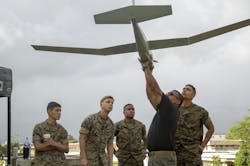Military researchers eye soaring capability to increase range and efficiency of small unmanned aircraft
ARLINGTON, Va. – U.S. military researchers are asking industry to develop soaring capabilities to increase efficiency and reduce energy consumption aboard small uncrewed aircraft.
Officials of the U.S. Defense Advanced Research Projects Agency (DARPA) in Arlington, Va., issued a program solicitation on Thursday (DARPA-PS-24-13) for the Albatross project to develop autonomous aircraft soaring capabilities.
The Albatross program seeks to develop unmanned aerial vehicle (UAV) soaring to help reduce onboard energy consumption by as much as 75 percent. Soaring is the harnessing of winds aloft to reduce energy use and increase the range and endurance of small unmanned aerial vehicles (UAVs).
The program has two goals: develop a preflight planning tool that helps the operator predict the performance of small UAVs with soaring benefits; and develop an onboard, real-time soaring guidance and control subsystem for small UAVs that recognizes soaring conditions and responds appropriately.
The preflight planning tool will give several options to help the aircraft fly through expected high-density soaring conditions. Types of soaring include static, such as thermal, ridge, and wave, and dynamic, such as across wind shear or through a boundary layer.
Program goals are to reduce onboard energy use by 75 percent across a range of missions; predict soaring energy consumption within 15 percent across a range of missions; and balance energy harvesting with mission objectives.
Albatross seeks to develop mission planning based on weather forecasts, and real-time onboard sensing of dynamic wind conditions to harness energy from winds.
The focus is on developing planning tools, aircraft sensors, and control to enable small unmanned aircraft to plan for, identify, and respond to soaring conditions autonomously.
Related: DARPA program to launch long-range UAVs from small ships expands to five contractors
Albatross focuses on real-world flight tests of small UAVs that aim at drastically extending range and endurance. Soaring includes static soaring, such as thermal, ridge, and wave soaring, and dynamic soaring, such as shear layer and boundary layer gradient soaring.
The technical focus of Albatross is on a preflight planning perk that uses forecasted weather, local geographical features, and aircraft performance to generate an efficient flight plan; and a sensing and harnessing control system that senses soaring flight conditions and provides autonomous commands to the UAV.
Companies interested should email five-page abstracts no later than 15 Nov. 2024 to [email protected]. Those submitting promising abstracts may be invited to give oral presentations in early December 2024.
Email questions or concerns to [email protected] by 24 Oct. 2024. More information is online at https://sam.gov/opp/bd0f1ea23d2d46a38d349b0cd4a442c1/view.
About the Author
John Keller
Editor-in-Chief
John Keller is the Editor-in-Chief, Military & Aerospace Electronics Magazine--provides extensive coverage and analysis of enabling electronics and optoelectronic technologies in military, space and commercial aviation applications. John has been a member of the Military & Aerospace Electronics staff since 1989 and chief editor since 1995.
